Once again to the question about the weight of knight armor ...
Shields, steel helmets and armor you have.
Ready for the faith to fight your dedicated sword.
Give me strength too, oh my god, for the new glorious sech.
I will take a rich booty there.
I do not need gold and land to anything,
But maybe I will, singer, mentor, warrior,
Heavenly bliss forever honored
(Walter von der Vogelweide. Translation by V. Levik)
A number of articles on the subject of knightly weapons and, in particular, knightly armor, have already been published on the VO website. However, this topic is so interesting that you can go deeper into it for a very long time. The reason for the next treatment is banal ... weight. Armor weight and weapons. Alas, I recently again asked students about how much a knight’s sword weighs, and received the following set of numbers: 5, 10 and 15 kilograms. They found the mail in 16 kg to be very light, though not all, and the weight of the plate armor in 20 with a small kilo is simply ridiculous.
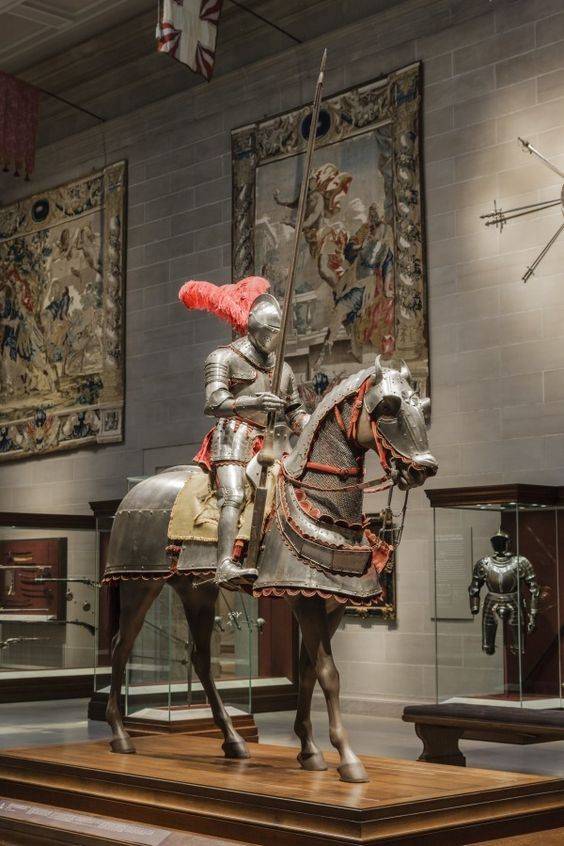
The figures of a knight and a horse in full protective gear. Traditionally, knights imagined just such - "chained in battens." (Cleveland Museum of Art)
At HE, of course, “weight matters” are much better due to regular publications on this topic. However, the opinion of the exorbitant severity of the “knightly costume” of the classical type has not been eradicated until now and here. Therefore, it makes sense to return to this topic and consider it with specific examples.
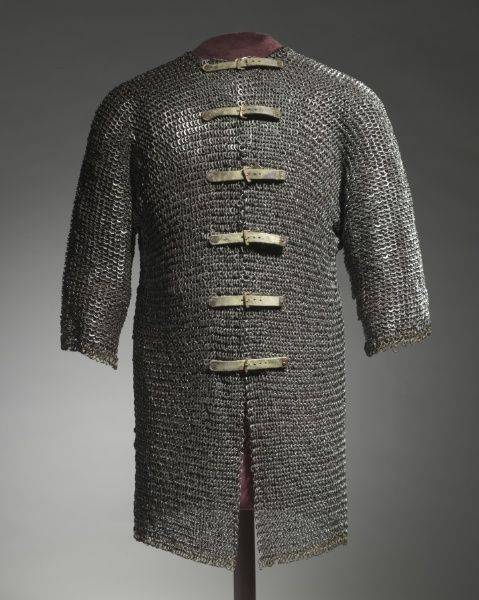
Western European hauberk (hauberk) 1400 - 1460's. Weight 10.47 kg. (Cleveland Museum of Art)
Let's start with the fact that British historians of armaments created a very reasonable and clear classification of armor according to their specific characteristics and eventually divided the entire Middle Ages, orienting, of course, according to available sources, into three eras: the epoch of chain mail, the epoch of mixed mail-plate protective weapons ”and“ the era of one-piece armor ”. All three eras together make up the period from 1066 to 1700 a year. Accordingly, the first era has the framework 1066 - 1250, the second - the era of chain mail-plate armor - 1250 - 1330. But further like this: the early stage in the development of knightly plate armor (1330 - 1410) stands out, the “great period” in stories knights in “white armor” (1410 - 1500) and the sunset era of knight armor (1500 - 1700).
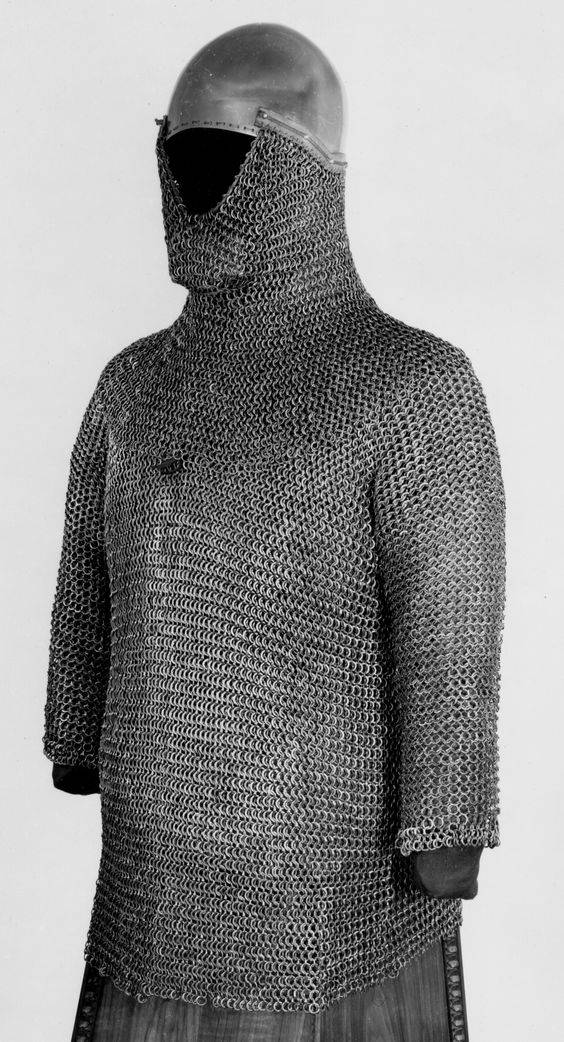
Chainmail along with a helmet and a bamlita (aventail) of the thirteenth to fourteenth centuries. (Royal Arsenal, Leeds)
During the years of the “wonderful Soviet education”, we have never heard of such a periodization. But in the school textbook "The History of the Middle Ages" for the VΙ class for many years with some rehash you could read the following:
“It was not easy to defeat the peasants even of a single feudal lord. The cavalry warrior, the knight, was armed with a heavy sword and a long spear. With a big shield he could hide from head to toe. The body of the knight defended chain mail - shirt, woven from iron rings. Later, the mail was replaced by armor - armor of iron plates.
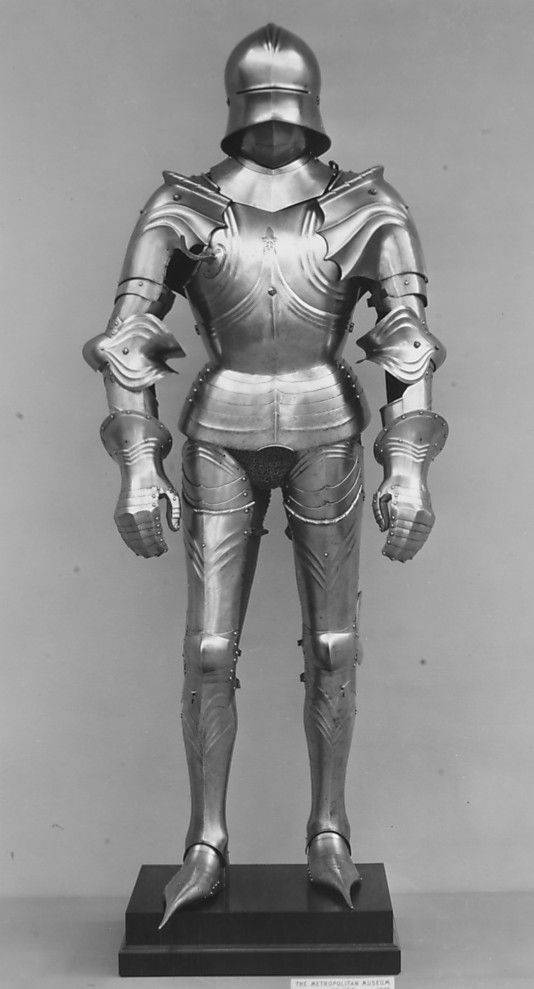
Classic knight armor, which in the textbooks for schools and universities most often discussed. Before us is Italian armor of the 15th century, restored in the 19th century. Height 170.2, see Weight 26.10 kg. 2850 helmet weight (Metropolitan Museum, New York)
Knights fought on strong, hardy horses, which were also protected by armor. The knight’s armament was very heavy: it weighed down to 50 kilograms. Therefore, the warrior was clumsy and clumsy. If the rider was thrown off his horse, he could not get up without help and was usually captured. To fight on a horse in heavy armor, it took a long training, the feudal lords prepared for military service from childhood. They constantly practiced fencing, riding, wrestling, swimming, javelin throwing.
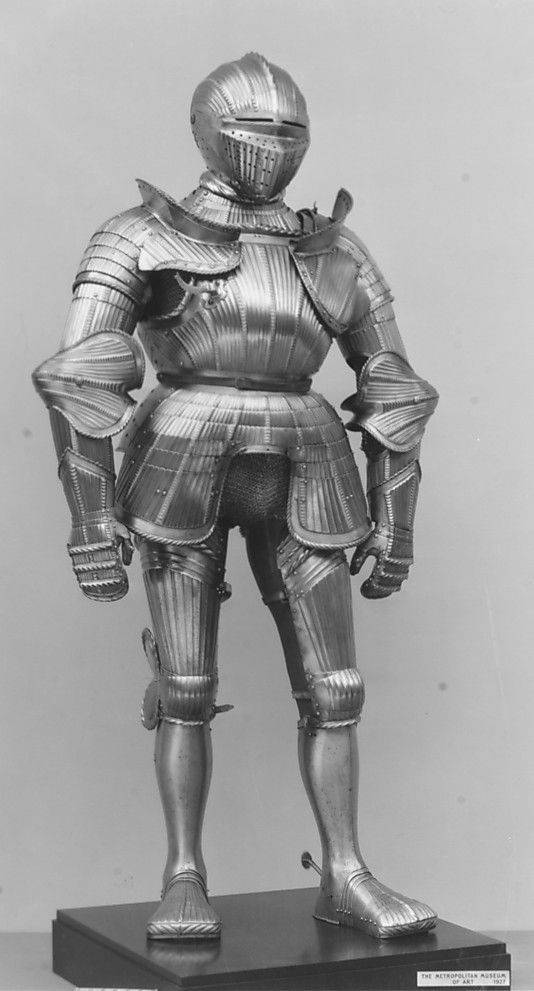
German lats 1535. Presumably from Brunswick. Weight 27.85 kg. (Metropolitan Museum, New York)
Warhorse and knightly weapons were very expensive: for all this it was necessary to give the whole herd - 45 cows! The landowner, on which the peasants worked, could carry the knightly service. Therefore, the military business became an occupation almost exclusively of feudal lords ”(Agibalova, EV The history of the Middle Ages: A textbook for the 6 class / EV. Agibalova, GM Donskoy, M .: Enlightenment, 1969. С.33; Golin, EM The history of the Middle Ages: A textbook for the 6 class of the evening (shift) school / EM Golin, VL Kuzmenko, M. Ya. Loyberg. M .: Enlightenment, 1965. C. 31- 32.)
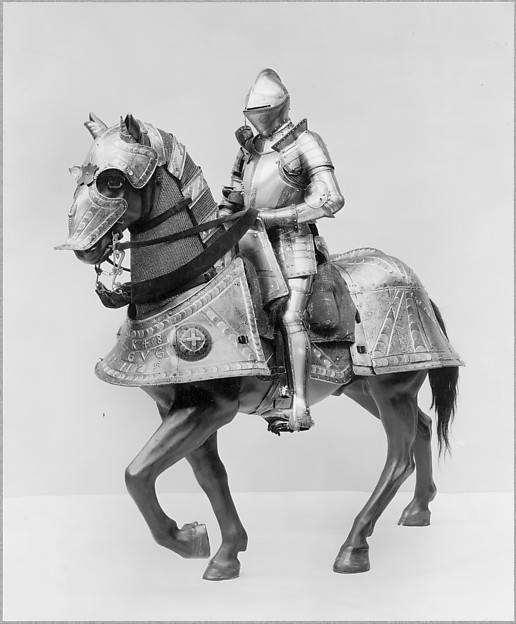
Knight in armor and horse in horse armor. The work of the master Kuntz Lochner. Nuremberg, Germany 1510 - 1567 Dated 1548 g. The total weight of rider's equipment, along with horse armor and 41.73 saddle kg. (Metropolitan Museum, New York)
Only in the 3 edition of the textbook "History of the Middle Ages" for the VΙ class of the secondary school V.A. Vedyushkina, published in 2002, the description of knightly weapons became somewhat truly thoughtful and relevant to the aforementioned periodization used by historians around the world today: “At first, the knight was protected by a shield, helmet, and hauberk. Then, the most vulnerable parts of the body were hidden behind metal plates, and from the 15th century onwards the chainmail was finally replaced by solid armor. The battle armor weighed up to 30 kg, so the knights chose enduring horses, also protected by armor, for the battle. ”
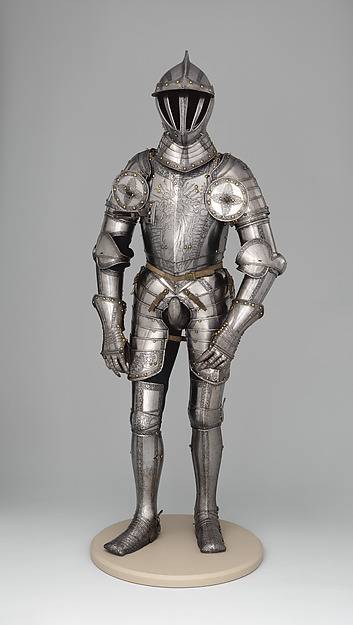
Armor of Emperor Ferdinand I (1503 – 1564) Gunsmith Kunz Lochner. Germany, Nuremberg 1510 - 1567 Dated 1549 d. Height 170.2, see Weight 24 kg.
That is, in the first case, intentionally or due to ignorance, the armor was divided over epochs simply, while the weight in 50 kg was attributed to both the armor of the “epoch of chain mail” and the “epoch of all-metal armor” without division into the knight's armor and the armor of his horse. That is, judging by the text, our children were offered information that "the warrior was clumsy and clumsy." In fact, the first articles on the fact that this is actually not the case were the publications of V.P. Gorelika in the "Around the World" journals in 1975, however, this information was never included in the textbooks for the Soviet school. The reason is clear. On anything, on any examples, show the superiority of the military affairs of the Russian soldiers over the "knight-dogs"! Unfortunately, the inertia of thinking and not too much of the importance of this information make it difficult to disseminate information corresponding to the data of science.
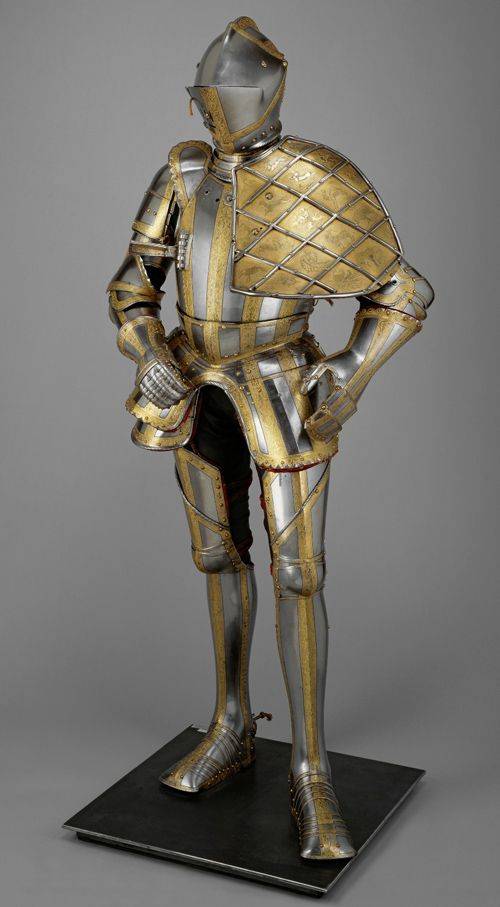
The 1549 armored set belonging to Emperor Maximilian II. (Wallace Collection) As you can see, the version in the photo is tournament armor, since they have grangards. However, it could be removed and then the armor became combat. This achieved considerable savings.
Nevertheless, the provisions of the school textbook V.A. Vedyushkina fully correspond to reality. Moreover, information about the weight of armor, well, let's say, from the Metropolitan Museum in New York (as well as from other museums, including our Hermitage in St. Petersburg, then Leningrad) was available for a very long time, however, in the books of Agibalov and Donskoy for some reason, it didn’t hit it in its time. However, why is just understandable. After all, we had the best education in the world. However, this is a special case, although quite indicative. It turned out that there were chain mail, then - rr-time and now the armor. Meanwhile, the process of their appearance was more than lengthy. For example, only around 1350 of the year did the appearance of the so-called “metal chest” with chains (from one to four) go to the dagger, the sword and the shield, and sometimes a helmet was also attached to the chain. The helmets at that time were not yet connected to the protective plates on the chest, but under them they wore chain mail hoods that had a wide shoulder. Around 1360, the lat appeared fasteners; in 1370, the knights almost completely dressed in iron plates, and chain mail was used as a base. There were also the first brigands - caftans, and a slab of metal plates. They were used as an independent type of protective clothing, and they were worn with chain mail, both in the West and in the East.
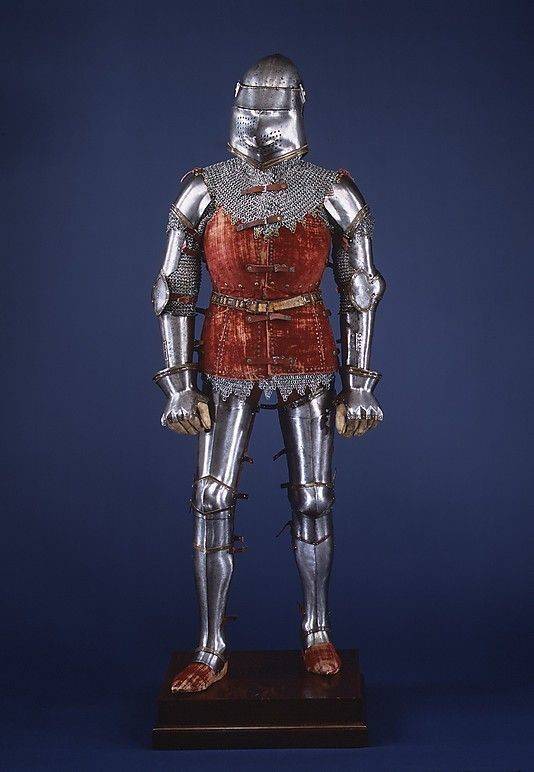
Knight's armor with a brigandine over the chain mail and helmet bascinet. Around 1400 – 1450 Italy. Weight 18.6 kg. (Metropolitan Museum, New York)
Since 1385, the hips have been closed with brass from articulated metal bands. In 1410, full-cover plate armor for all parts of the body spread throughout Europe, but the chain mail cover of the throat was still used; in 1430, the first grooves appeared on the elbow and kneecaps, and by the 1450, armor from forged steel sheets had reached their perfection. Beginning with 1475, the grooves on them are becoming increasingly popular, while fully corrugated or so-called "Maximilian armor", whose authorship is attributed to the Holy Roman Emperor Maximilian I, does not become the measure of the skill of their manufacturer and the viability of their owners. Later, the knight's armor became smooth again - fashion influenced their form, but the skills achieved in the mastery of their decoration continued to develop. In the armor now not only people fought. The horses received it, and as a result the knight with the horse turned into something like a real statue of metal polished and glittering in the sun!
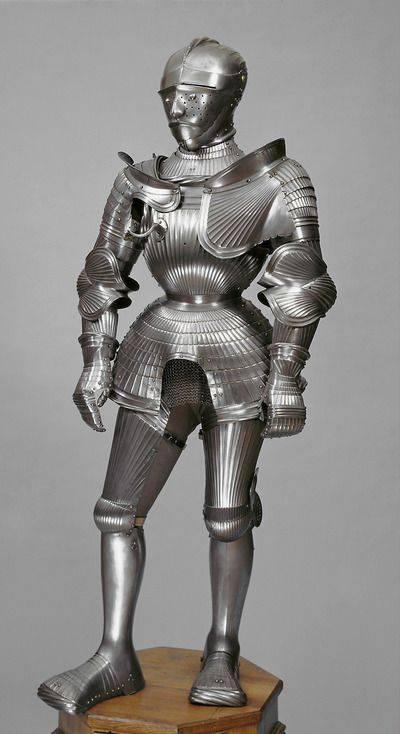
Another “Maximilian” armor from Nuremberg 1525 - 1530. Belonged to the Duke Ulrich - the son of Heinrich of Württemberg (1487 - 1550). (Museum of Art History, Vienna)
Although ... although the mods and innovators, "running ahead of the locomotive," were also always. For example, in 1410, it is known that a certain English knight named John de Fiarles paid pounds sterling to the Burgundian gunsmiths 1727 for the armor, sword and dagger he ordered to decorate with pearls and ... diamonds (!) - a luxury not only unheard of time, but even for him at all and not characteristic.
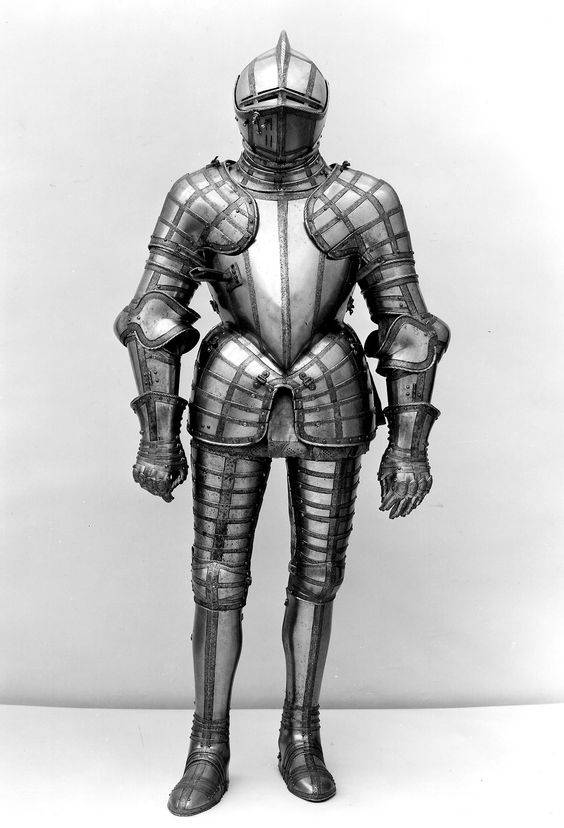
Sir John Skudamour's Field Armor (1541 or 1542 – 1623). Gunsmith Jacob Jacob Halder (Workshop in Greenwich 1558 – 1608) Near 1587, restored in 1915, Weight 31.07 kg. (Metropolitan Museum, New York)
Every detail of plate armor got its name. For example, the plate for the thighs was called cuisses, kneecaps - polens (poleyns), jambers - for the legs and sabatons for the feet. Gorget or bevor (gorgets, or bevors), defended the throat and neck, cutters (couters) - elbows, e (c) paullers, or halfprones (espaudlers, or pauldrons), - shoulders, rere (e) braces (rerebraces) - forearm , vambraces (vambraces) - part of the hand down from the elbow, and gant (e) years (gauntlets) - this is "plate gloves" - protected the hands. The helmet also belonged to the complete set of armor and, at least, at first, the shield, which later ceased to be used on the battlefield by about the middle of the 15th century.
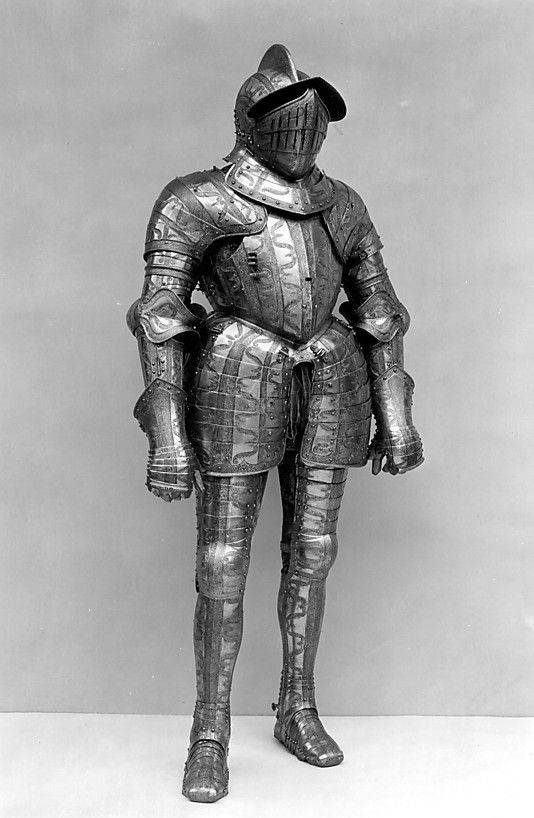
The armor of Henry Herbert (1534 – 1601), the Second Earl of Pembroke. Manufactured around 1585 - 1586. at the Greenwich Gunshop (1511 - 1640). Weight 27.24 kg. (Metropolitan Museum, New York)
As to the number of parts in the “white armor”, in the armor of the mid-fifteenth century their total number could reach 200 units, and taking into account all the buckles and nails, along with hooks and various screws, even to 1000. The weight of the armor was 20 - 24 kg, and it was evenly distributed throughout the body of the knight, unlike the chain mail that pressed the man on his shoulders. So “no crane was needed at all to put such a rider in his saddle. And when he was knocked off the ground, he did not look like a helpless beetle at all. ” But the knight of those years was not a mountain of meat and muscles, and he did not rely on just one brute force and animal ferocity. And if we pay attention to how knights are described in medieval works, we will see that very often they had a fragile (!) And elegant physique, and at the same time they had flexibility, developed muscles, and were strong and very agile, even being dressed in armor, with well-developed muscle response.
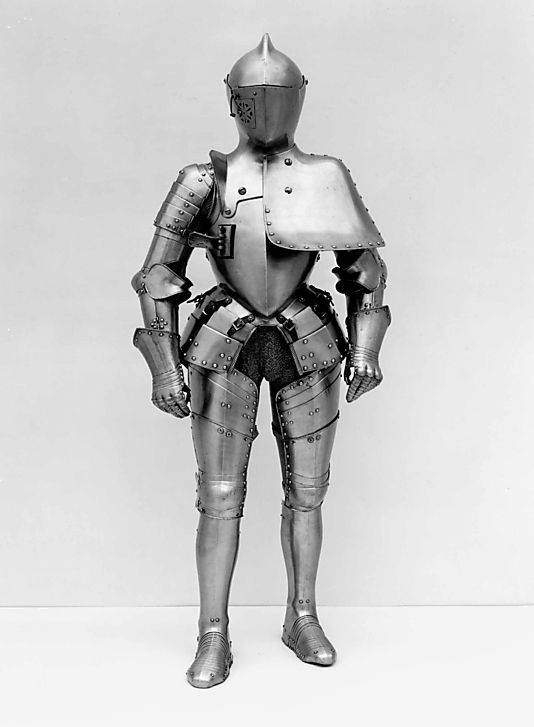
Tournament armor made by Anton Poffenhauser around 1580 (Germany, Augsburg, 1525 – 1603) Height 174.6 cm; width at the shoulders 45.72 cm; 36.8 weight kg. It should be noted that tournament armor has usually always been heavier than combat. (Metropolitan Museum, New York)
In the last years of the 15th century, knightly armament became a subject of special concern for European sovereigns, and in particular, Emperor Maximilian I (1493 - 1519), who is credited with creating knightly armor with grooves all over their surface, ultimately called "Maximilian." It was used without any changes in the 16th century, when new improvements were needed due to the ongoing development of small arms.
Now quite a bit about swords, because if you write about them in detail, they deserve a separate topic. J. Clements, a famous British expert on cold arms of the Middle Ages, believes that the appearance of multi-layer combined armor (for example, in John de Creck's effect we see as many as four layers of protective clothing) led to the appearance of a sword and a half hands. Well, the blades of such swords ranged from 101 to 121 cm, and weight from 1,2 to 1,5 kg. And the blades are known for chopping and stabbing, and already purely for stabbing. He notes that these swords were used by horsemen up to the 1500 year, and they were especially popular in Italy and Germany, where they were named Reitschwert (horseman) or knight's sword. In the 16th century, swords with wavy and even serrated sawtooth blades appeared. At the same time, their length itself could reach human height with weight from 1,4 to 2 kg. Moreover, in England, such swords appeared only around 1480 of the year. The average weight of the sword in the X and XV centuries. was 1,3 kg; and in the sixteenth century. - 900. The “hand and a half” Bastard Swords had a weight of about 1,5 - 1,8 kg, and the weight of double hands was rarely more than 3 kg. The latter reached their heyday between 1500 - 1600, but they have always been infantry weapons.
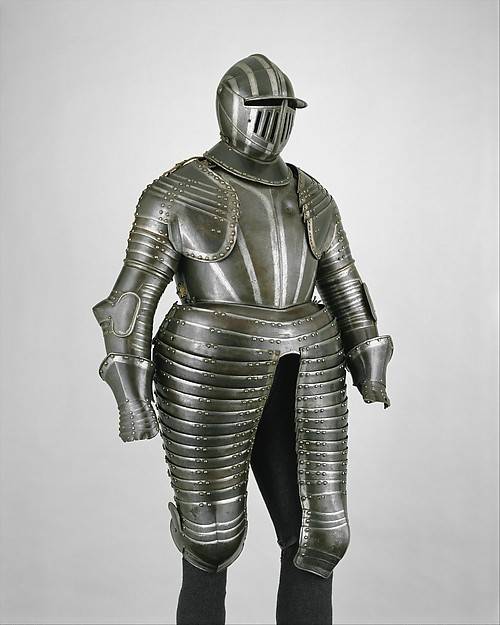
Cuirassier "Three Quarter" armor, approx. 1610 – 1630 Milan or Brescia, Lombardy. Weight 39.24 kg. Obviously, since they have no armor below the knees, the weight of the excess weight was obtained due to the thickening of armor.
But the shortened armor by three quarters for cuirassiers and pistollers, even in their shortened form, often weighed more than those that assumed protection only from knives and they were very heavy to wear. The cuirassier armor has survived, weighing about 42 kg, i.e. even more classic knight armor, although they covered a much smaller surface of the body of the one to whom they were intended! But this, it should be emphasized, is not knight’s armor, that's what's the matter!
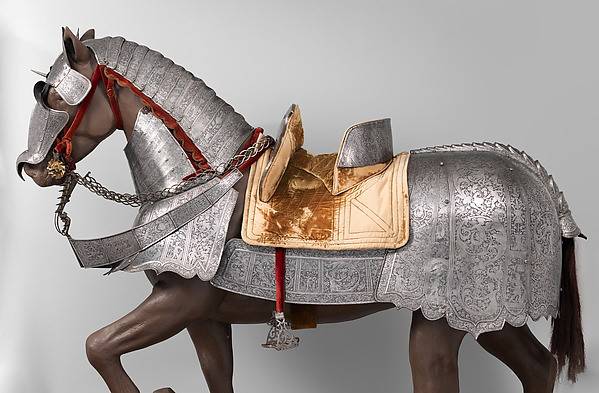
Horse armor, possibly made for Count Antonio IV Kolallto (1548 – 1620), around 1580 – 1590. Place of manufacture: probably Brescia. Weight with 42.2 saddle kg. (Metropolitan Museum, New York) By the way, a horse in full armor could even swim under a rider in armor. Horse Armor weighed 20 – 40 kg - a few percent of the weight of a huge and strong knight's horse.
Information